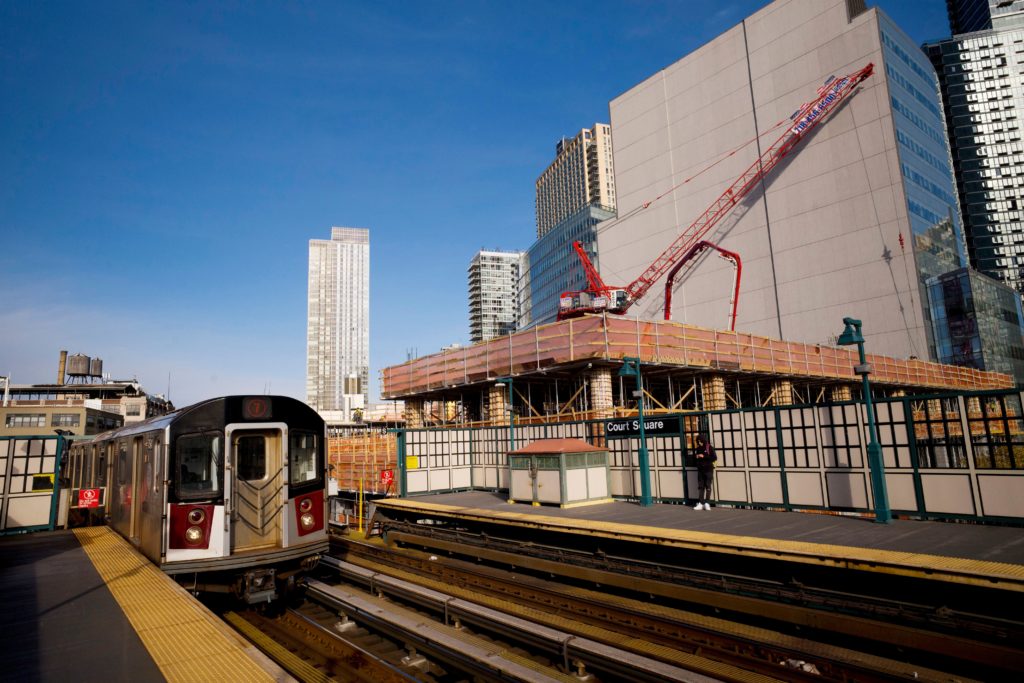[ad_1]

Construction along the Court Square subway platform in Long Island City, Queens.
MARK LENNIHAN/AP/REX/SHUTTERSTOCK
Last month, the mayor of London released a plan to address the growing affordability crisis facing the city’s artists and creators. The document’s wonky title, the Cultural Infrastructure Plan, belies the bold vision Mayor Sadiq Khan lays out to protect and grow the spaces where London’s artists, musicians, dancers, and other creators produce and share culture.
With similar challenges threatening New York City’s artists and venues, city leaders and local officials should consider taking a page from London’s sketchbook.
Highlighting the crucial role the creative industries play within London’s economy and social tapestry, Mayor Khan provides an ambitious blueprint to sustain and grow the city’s cultural infrastructure. This plan recognizes that London’s arts and creative industries have become indispensable to the city’s overall economy, while identifying the enormous threat posed by the affordability crisis rippling through the city’s cultural hubs. To make its case, the report is unsparing in documenting how the city has not done enough in recent years to adequately support spaces for artists to live, work, exhibit, and perform.
The echoes of New York City are unmistakable: From escalating rents and operating costs to licensing and funding restrictions, the dance studios, music venues, theaters, workshops, and even skateparks that make London a global cultural capital are under unprecedented pressure. Over the past 10 years, London has lost 35 percent of its grassroots music venues, half of its nightclubs, and 61 percent of its LGBT+ venues, according to London’s Deputy Mayor for Culture and the Creative Industries. Without a major intervention, the city is set to lose 24 percent of its artists’ workspaces over the next five years.
Just like in London, artists and arts organizations provide the key building blocks of New York City’s broader creative economy, which supports roughly 300,000 jobs across the five boroughs. But there’s another, more painful, similarity: New York City has likewise been losing art spaces, affordable studios, and grassroots venues at a rapid clip.
The Center for an Urban Future’s 2015 Creative New York report documented at least 24 independent music venues that closed between 2011 and 2015. Gallery and performance spaces have experienced similar declines as leases expire and rent, regulatory, and operating costs surge. For instance, rents rose by at least 32 percent from 2000 to 2012 in the city’s neighborhoods most closely associated with art and creativity, displacing longtime residents and artists alike.
These factors make New York City an incredibly challenging place to live and work as an artist—and increase the appeal of more affordable cities, from Detroit to Mexico City.
Two years ago, New York City’s Department of Cultural Affairs launched its own cultural plan, CreateNYC. CreateNYC proposed several thoughtful and important initiatives, including investments in a more diverse and inclusive cultural workforce, increased funding for organizations in low-income communities, and expanded cultural access for people with disabilities—all highly worthy goals.
What CreateNYC doesn’t do is tackle New York’s own affordability crisis head-on.
Mayor de Blasio and Department of Cultural Affairs Commissioner Tom Finkelpearl can help confront this growing challenge, in part, by borrowing or adapting a few smart ideas from London’s approach.
For instance, Mayor Khan is helping to fund an independent Creative Land Trust that will provide financing for the purchase of buildings to be used as permanently affordable workspaces for artists in London. By helping studio operators access capital that isn’t currently available from other sources, the Creative Land Trust hopes to secure 1,000 affordable workspaces in its first five years.
London is also establishing six Creative Enterprise Zones, which provide funding to create new affordable workspaces for artists and creative businesses while establishing training programs that help local residents access jobs in the creative economy.
Mayor Khan has set up London’s first-ever Culture at Risk Office, a de facto hotline that cultural venues at risk of closure can turn to for help. The office has already helped save more than 300 venues.
The mayor also enacted new planning rules to protect London’s nightlife venues. In recent months, for instance, the rules helped protect a West End nightclub which would have been lost as part of the redevelopment of the building it occupied. The mayor’s new planning policies were used to ensure that an entertainment venue will be part of the new development.
Of course, London isn’t the only source of good ideas for addressing the affordability challenges facing so many of the city’s working artists and nonprofit arts organizations. There are other things Mayor de Blasio can do. For instance, New York’s public schools contain thousands of art, dance, music, and theater spaces that sit empty most weekends and for two-thirds of each weekday. The city can share these spaces with local artists, providing affordable work space in communities across the city—and should start by piloting 10 schools this year.
To maintain its place as a creative capital of the world, New York needs to be bold in pursuit of sustainable cultural infrastructure in every community. London’s forward-thinking approach should serve as a welcome source of inspiration.
Jonathan Bowles is executive director of the Center for an Urban Future, a New York City–based think tank focused on expanding economic opportunity. Eli Dvorkin is CUF’s editorial and policy director.
[ad_2]
Source link

